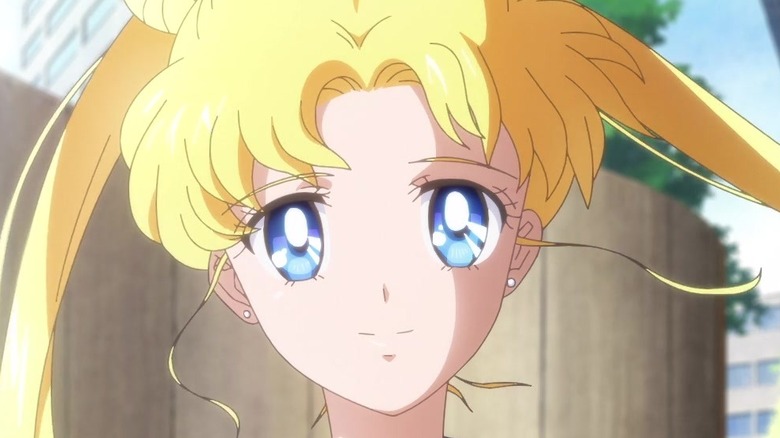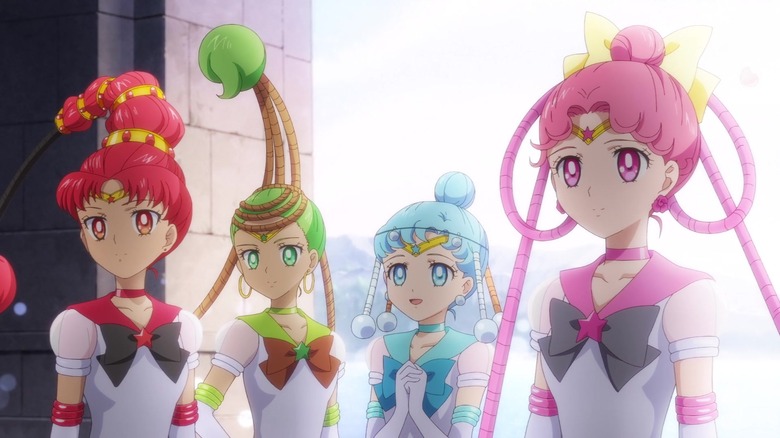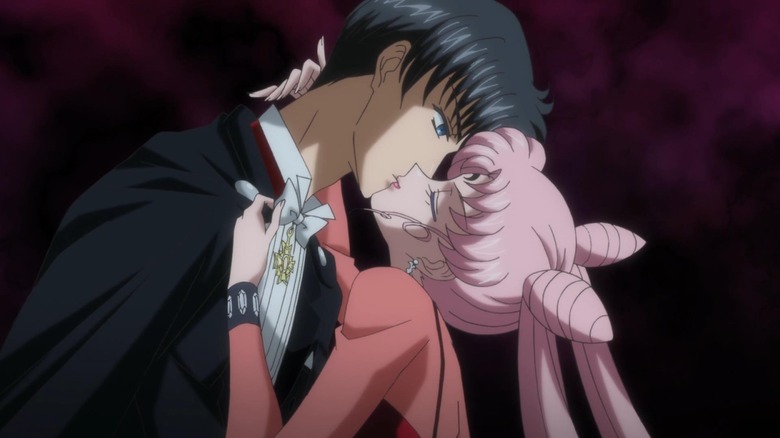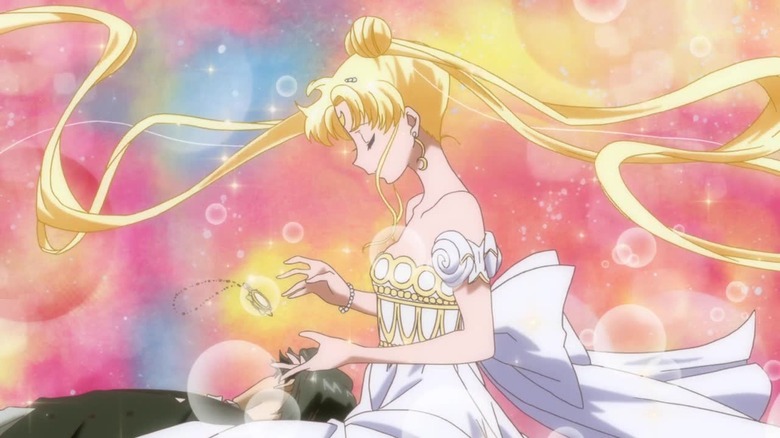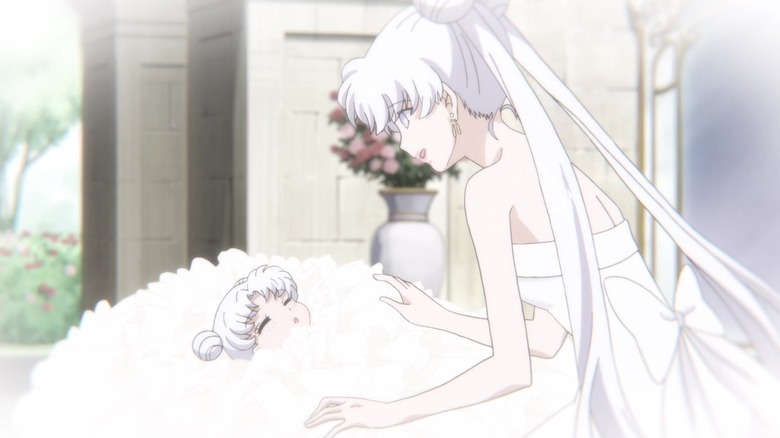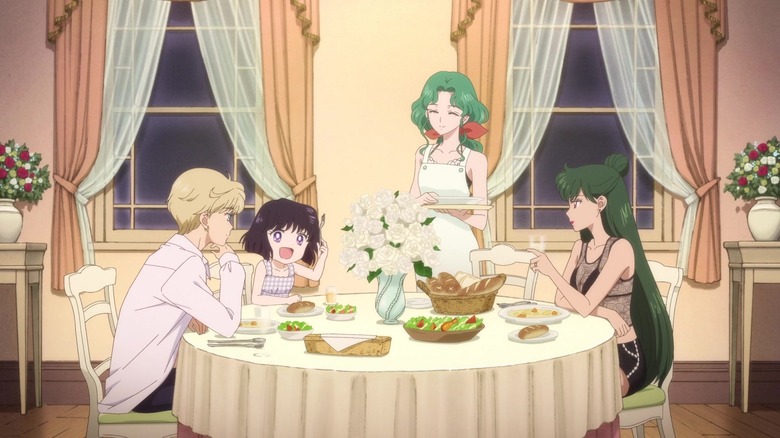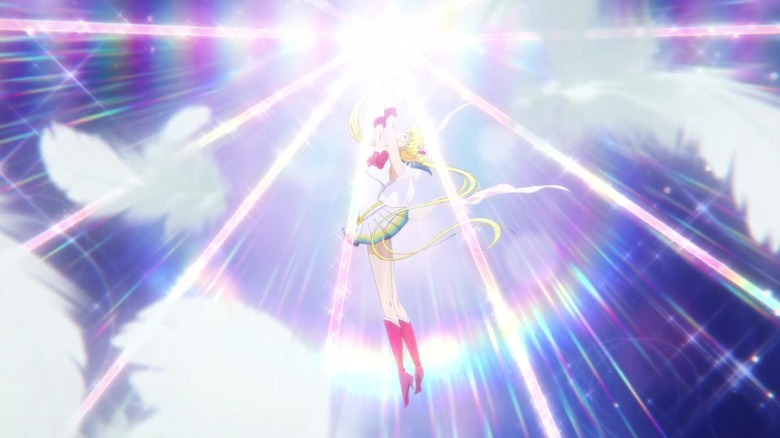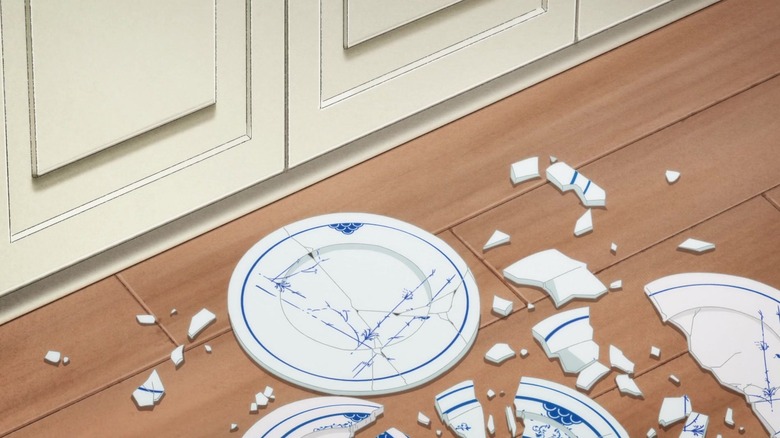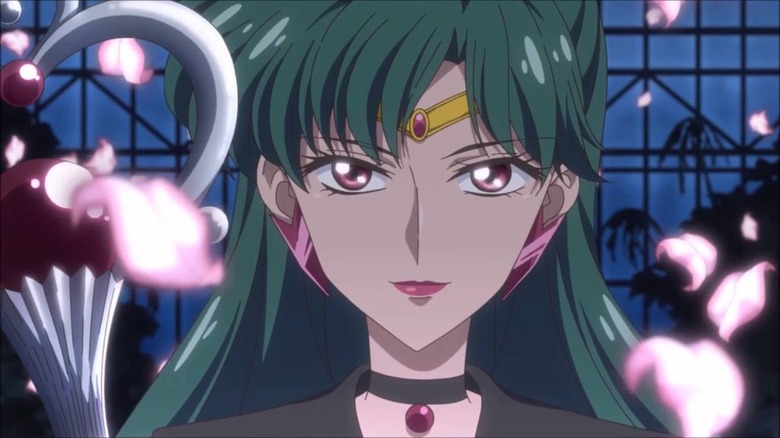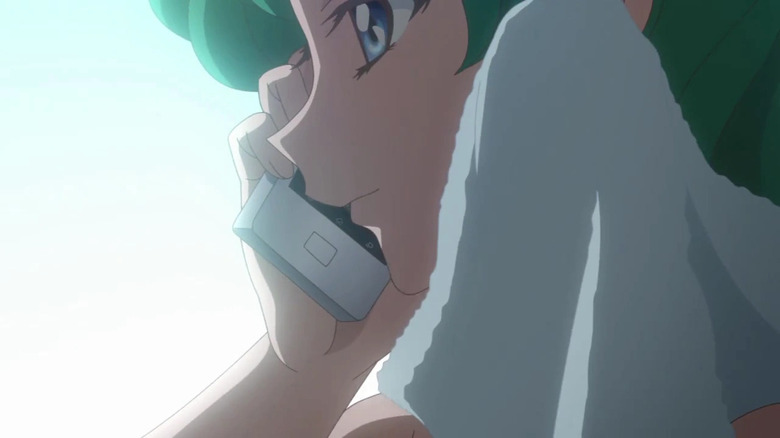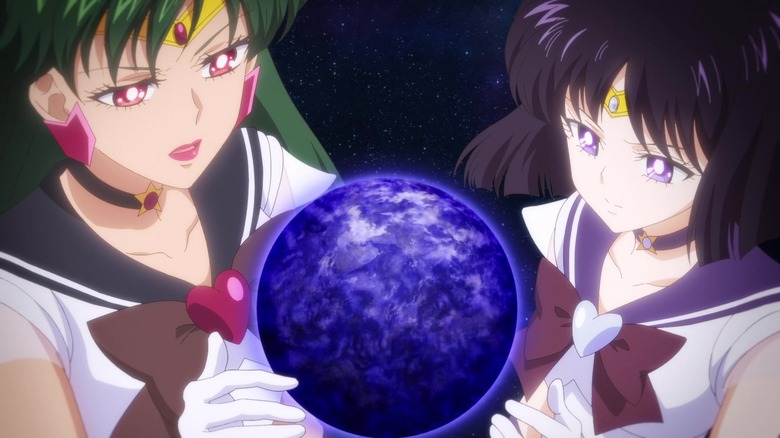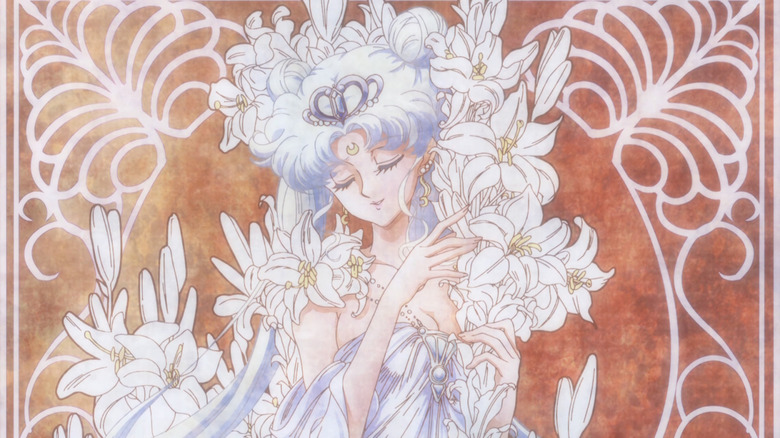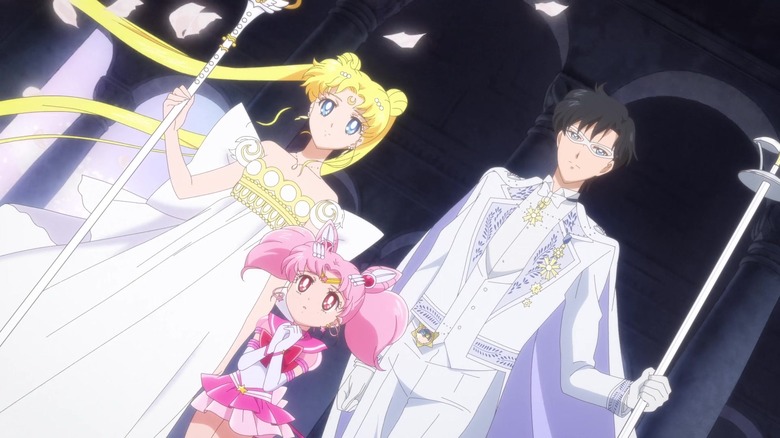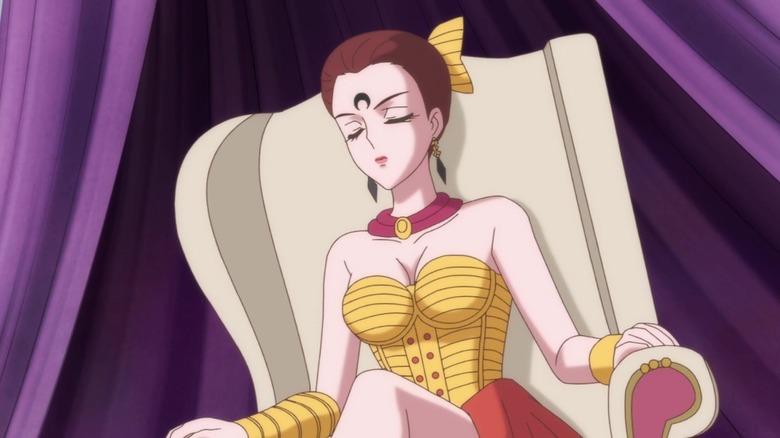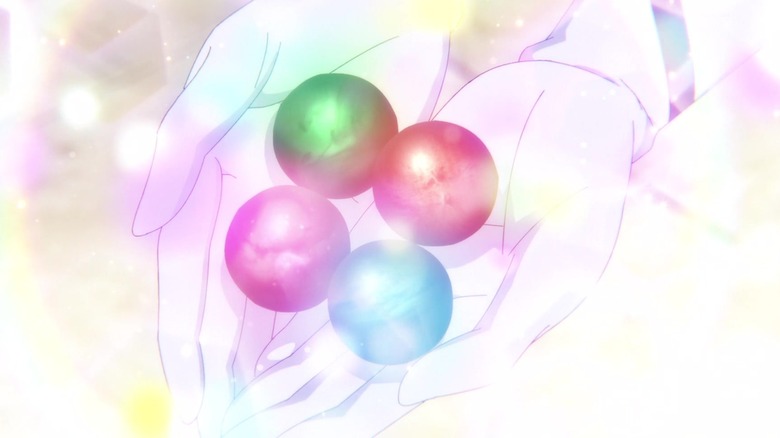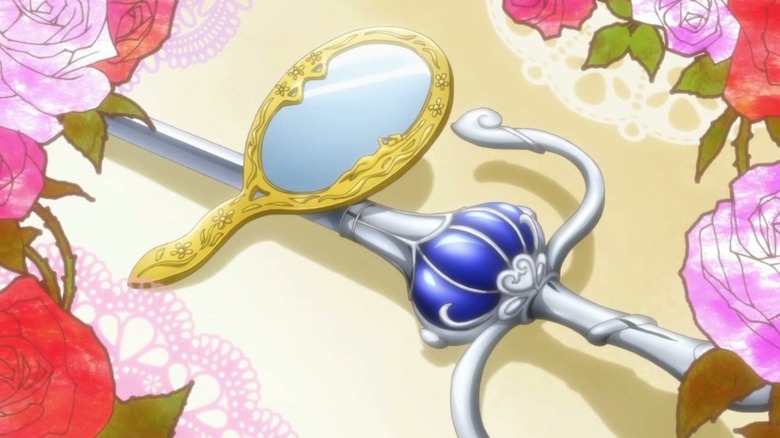Things Only Adults Notice In Sailor Moon Crystal
The world of "Sailor Moon Crystal" runs on the hope of teenage girls. Evil is vanquished with bedazzled wands and attacks like "Moon Gorgeous Meditation." Luminous queens wearing fabulous gowns live in crystal palaces. The power of friendship isn't just capable of saving the day — it can overrule the actual, literal apocalypse. It's no wonder children have been falling in love with Usagi Tsukino's world for decades, really. Here, good doesn't just triumph over evil — it does so in a storm of sparkles, magical cats, immortal princesses, and a flying horse or two.
But even "Sailor Moon Crystal" is not without its obscure corners and dark alleyways. There's a reason every convention is still packed with adults dressed as their favorite Sailor Guardian — the "Sailor Moon" mythos has a lot to offer the adult mind. "Sailor Moon Crystal," the newest addition to the canon, is no exception: This anime is jam-packed with references, oddities, and in-jokes only the grown-up viewer will notice. From the Moon Kingdom's real-world couture to the mystery of Princess Serenity's parentage, these are the "Sailor Moon Crystal" details aimed squarely at the adult audience.
There might be way more Sailor Guardians than we think
Our heroines spend much of "Sailor Moon Eternal: The Movie" being terrorized by the fearsome Amazoness Quartet. These colorful henchgirls are as adorable as they are deadly — but in fact, their giggly malice is a pose. As Sailor Saturn deduces, Queen Nehelenia has twisted their powers towards her own fiendish ends. By the end of "Eternal," their true forms have been revealed: They, too, are Sailor Guardians, meant to be sleeping in the Amazon until Chibi-Usa comes of age.
"But wait," the astronomy-savvy adult might be thinking, "the cosmology of 'Sailor Moon Crystal' ties each Guardian to a specific planet. Where the heck is the Quartet from?" As it turns out, each Quartet member corresponds to an asteroid: 1 Ceres, 4 Vesta, 2 Pallas, and 3 Juno. These celestial bodies are among the biggest denizens of the asteroid belt — 1 Ceres is so large, in fact, that it is considered a dwarf planet.
Anyone can appreciate this astronomy lesson, but an adult will boggle at its implications. If Guardians aren't actually confined to planets, do all asteroids have one? Given the fact that there are over 1 million asteroids in the solar system, does that imply the existence of way more Guardians than we ever see on screen? What about other heavenly objects, like comets? Is there a Sailor Hale-Bopp out there in the cosmos, waiting for Sailor Moon's great-great-great-granddaughter to assume the responsibilities of Sailor Guardianship?
Black Lady's Electra complex
Season 2 of "Sailor Moon Crystal" brings time travel into the mix with the arrival of the mysterious Chibi-Usa. A pink-haired girl with magical toys and a reluctance to reveal anything about herself, she immediately drives a wedge between Usagi and Mamoru. This is mostly understandable: Chibi-Usa latches onto an amenable Mamoru, and, well, Usagi is a territorial teenager. Sure, Chibi-Usa is a kid, and Mamoru is clearly treating her with the concern any kind adult might have for a frightened child. But who among us is rational at the age of 14?
Once Chibi-Usa is revealed to be Usagi and Mamoru's daughter, however, things get a little screwy. Though Usagi does eventually realize she's being ridiculous, her interactions with Chibi-Usa never quite lose their edge, and she remains deeply jealous of any time Mamoru spends with their time-displaced child. It's hard for the adult viewer not to find this a bit much ... but then again, it's hard for the adult viewer not to notice, uncomfortably enough, that Usagi has a bit of a point. Upon being transformed into the grown-up Black Lady, Chibi-Usa's interest in Mamoru solidifies into an out-and-out Electra complex, culminating in her planting a straight-up kiss on him. Again, Mamoru is her dad. Black Lady might be born from Chibi-Usa's darkest impulses, but that's a bit much for even the most twisted villainess.
Fighting evil in real-world couture
All the world's a runway in "Sailor Moon Crystal." Haruka Tenoh's hair is never less than perfectly tousled. Tuxedo Mask's duds are crisply pressed. Crucial story beats are nearly always accompanied by a change of costume. This is, of course, pretty standard in the world of anime — and really, the world of entertainment at large. Good-looking people prance across our screens in dazzling outfits as often in "Cowboy Bebop" and "Game of Thrones" as they do in "Sailor Moon Crystal."
But in fact, characters in "Sailor Moon Crystal" really are taking things up a notch by wearing actual garments from real-world designers. Most prominently, Princess Serenity's gown is the "Palladium" dress from Christian Dior's 1992 Spring/Summer collection. That's right: Usagi is blasting away bad guys in Dior couture. The villainesses of "Sailor Moon Crystal," in contrast, favor the wickedly sharp points and rigid accents of Thierry Mugler. Koan takes her look from his 1992 Fall/Winter collection, while the horned shape of Queen Beryl's bodice can be spotted in his 1992 Spring ready-to-wear line. Unlike her sister, Calaveras favors Christian Lacroix — specifically, his 1992-1993 Fall/Winter collection. Beyond "Sailor Moon Crystal," the "Sailor Moon" artbooks are full to bursting with real-world finery from the likes of Chanel, Yves Saint Laurent, and ... well, a whole lot more Mugler. What can we say? Naoko Takeuchi has her favorites — and they're fabulous.
Where is Princess Serenity's dad?
When Queen Nehelenia interrupts Princess Serenity's christening in "Sailor Moon Eternal: The Movie," she ruins quite the fabulous party. A crowd of cheerful guests have gathered, as well as Sailors Mercury, Mars, Jupiter, and Venus. Though they're children, they're eager to pledge their loyalty to the heir to the Silver Millennium. Queen Serenity stands at the center of the festivities, glowing with joyous new motherhood. Everyone who is anyone is there.
That group does not include, apparently, the baby's father. In fact, one soon realizes that no mention is ever made of a husband to Queen Serenity, or a father of Princess Serenity. So ... where did Princess Serenity come from? Is this an immaculate conception situation? Do the people of the Moon reproduce by budding? The Silver Millennium is powered by advanced technology — could Queen Serenity have cloned herself?
All of these answers are possible. The Silver Millennium is a hazily depicted time, and the biology of Moon-dwellers is murkier still. If the Silver Crystal can perform miracles, why can't it create a baby? If the people of the Moon can live for centuries at the perma-stalled age of 22-ish, why couldn't they reproduce asexually? It's not weirder than anything else in "Sailor Moon Crystal," really. But the adult viewer can't help but ponder how dramatically this must have affected Silver Millennium culture ... and how weird the image of Queen Serenity producing her daughter like a sea sponge is.
Haruka and Michiru live impossible lives
Season 3 of "Sailor Moon Crystal" ends with Uranus, Neptune, and Pluto vowing to raise baby Hotaru together. "Sailor Moon Eternal: The Movie" finds them making good on this promise: They share a bucolic manor surrounded by roses, lively with gourmet dinners, violin lessons, and rowdy games. This is all very pastoral, but an adult viewer can't help but balk. Six months prior, Haruka and Michiru were teenagers. Who sold them this house? Do none of the parents who send their kids to Michiru for music lessons ever ask why she isn't in school?
Once one zeroes in on this absurd situation, the bizarre nature of Haruka and Michiru's lives becomes glaring. They were high schoolers six months ago, sure, but they were high schoolers who took helicopters to school from the comforts of their deluxe apartments, which they apparently had to themselves. Oh, and we can't forget the fact that Michiru is an internationally famous musician, nor that Haruka is a celebrated F1 racecar driver. Haruka alludes to mysterious "patrons" in Season 3, who allow them to live in such high style. Whether she means Michiru's fans, talent managers, or something else isn't clear.
Frankly, nothing about their lives makes sense — but really, would you want it any other way? Half the fun of Haruka and Michiru (and, to a lesser extent, Setsuna) is how well they serve as fabulous fantasies of glamorous adulthood. Bring on the helicopters!
Sailor Moon is basically God
So, there's this incredibly powerful being. They can bring people back from the dead, overturn the apocalypse, vanquish virtually all evil, and endure for thousands of years. They have lived multiple lives and occupy a place of supreme importance in their society. The belief of others enhances this being and leads to peace and prosperity. This description applies to a god. It also applies to Sailor Moon.
It's not just that Sailor Moon becomes virtually omnipotent as the seasons of "Sailor Moon Crystal" fly by, either. She is also closely associated with items, iconography, and titles swiped from actual religion. Season 3 even sees her manifest the Holy Grail — called by that name and everything — out of belief in herself and her loved ones. If "Sailor Moon Crystal" continues to adapt the manga, things will get even more blatant: We're talking "Sailor Moon defeats the primordial force of chaos at the origin point of existence" blatant. Even if the series never gets that far, however, we know Usagi will soon become god-empress of the solar system, capable of resurrecting Sailor Pluto, extending her subjects' lives to 1,000 illness-free years, and undoing Armageddon, as she does in Season 3. Who knew humanity should have been praying to giggly Japanese schoolgirls this whole time?
Michiru has expensive taste
The second half of "Sailor Moon Eternal: The Movie" begins by painting a portrait of domestic bliss. Haruka, Michiru, and Setsuna have established a lovely life together in the months since Pharaoh 90's defeat: They have a gorgeous country house, fulfilling careers, and, of course, little Hotaru. Within half a year, she's grown from an infant into a bubbly child (something Haruka, who excitedly spots a sale on diapers and formula, has to be reminded of). Though her body is growing like a weed, her mind might just be outstripping it, evidenced by the fact that she is, according to Michiru, reciting poems by Virgil of her own free will. Yet she is still a child, a fact made apparent when she breaks a pile of fine dishes.
"My vintage plates," Michiru laments, her face dark with frustration. Adults with a taste for the finer things in life might feel a shiver go down their spine as the broken china is shown: Hotaru has sent a number of Royal Copenhagen pieces to a jagged grave. A Danish outfit dating back to 1775, Royal Copenhagen has a long and elegant history. Their china is highly sought-after by collectors and has always been synonymous with luxury and class. Michiru's shattered plates bear the company's classic Blue Fluted pattern ... which means Hotaru just smashed a few hundred dollars' worth of china. Quick — distract her with another poem!
Queen Serenity forced Sailor Pluto into an awful life
Sailor Pluto occupies an interesting position. The Guardian of time, she stands alone beside the Space-Time door, blessed — or perhaps cursed — with its protection. Three taboos constrain her: She must not travel through time, she must never abandon her post, and she must never stop time. If she breaks that last rule, she dies — which, in fact, happens in the penultimate episode of Season 2.
Viewers of a more mature mindset can't help but find fault with this situation. First off, the first two taboos are broken multiple times, with no repercussions. Isn't it a bit silly that only the third incurs punishment? Secondly, consider the fact that she gets to live a normal life in later seasons, without bringing the cosmos to an end. Why was she condemned to such a solitary existence in the first place?
It's hard not to see Queen Serenity as a bit of a villain here. Given that the Space-Time Door is in the Crystal Palace and only those with the blood of the Silver Millennium can use it, it seems likely the queen created the door and its arbitrary rules. Given the enormity of her power and Pluto's eventual freedom, we're forced to conclude Queen Serenity could have found another way ... and didn't. She might have been the benevolent ruler of the Silver Millennium, but she sure didn't do right by poor Sailor Pluto.
The 1990s, now with smartphones
"Sailor Moon Crystal" might be a product of the new millennium, but the "Sailor Moon" franchise will always be rooted in the 1990s. That is, of course, the decade in which Naoko Takeuchi's landmark manga first hit stands, was adapted into an anime, and sailed overseas to dazzle millions. As such, the original manga and anime feature the fashion, technology, and architecture of that decade: The pants are high-waisted, the phones are attached to the walls, and the space shuttle program remains robust.
Because "Sailor Moon Crystal" closely adapts the manga, it contains many of these now-retro trappings. But every so often, it shoves a smartphone into someone's hand. To adult viewers, this creates a bizarre mashup reality that falls apart the moment one thinks about it too hard: Much of the '90s-inspired world of "Sailor Moon Crystal" is simply incompatible with modern tech. Arcades are still an everyday part of life here, filled with cabinet-bound games. Advanced computer setups require enormous amounts of space and largely lack touchscreens. The fact that the Guardians gain wristwatch-style communicators is no longer a cool perk of being superheroes — one wonders, in fact, why they even bother with something lacking the functionality of the magical rectangles everyone already has in their pockets. But really, it's hard to be too bothered — the fact that arcades conceal top-secret lairs in the world of "Sailor Moon Crystal" is way too cool to give up.
The mixed-up myths of Sailor Saturn and Sailor Pluto
Greco-Roman mythology is woven throughout "Sailor Moon Crystal," as anyone with even a passing acquaintance with the pantheon could tell you. Sailors Venus and Mars are, like the gods who share their names, all about love and war, respectively. The Endymion of ancient Greece also earns the love of the Moon, in the form of the goddess Selene. Sailor Jupiter has an eye for cute boys, much like Jupiter, king of the gods, has an eye for ... well, just about everyone.
Sailor Saturn and Sailor Pluto, however, complicate this neat narrative. According to myth, Pluto, known to the Greeks as Hades, presides over the land of the dead, while Saturn, who corresponds to the Greek Cronus, is associated with the passage of time. Yet it is Sailor Pluto who guards the Space-Time Door and Sailor Saturn who commands the power of death.
Is this a case of creative sloppiness? Not so, as the classics-savvy adult might realize. Sailor Pluto calls herself a daughter of Chronos, a figure long conflated with Cronus, implying a very interesting cosmology at work in "Sailor Moon Crystal." Beyond that, Sailor Saturn's identification with her deity can be understood on a metaphorical level: Much like Hotaru's dad sacrifices her to dark forces, so, too, does Saturn sacrifice his children for the sake of power. Thankfully, Professor Tomoe stops short of literally devouring his daughter as the mad god does.
Neo-Queen Serenity is a despot
Season 2 of "Sailor Moon Crystal" reveals the future lying in wait for our heroines, and boy, is it fabulous. At age 22, Usagi takes her rightful place on the Moon Kingdom's throne, becoming Neo-Queen Serenity. An era of peace begins: Crystal Tokyo (like Tokyo, but with a giant, sparkly palace) is established, Serenity's rulership comes to encompass the entire world, and her powers extend the average human life span to 1,000 years. The details of this Pax Lunaris are vague but splendid: Usagi's reign seems to bring an end to war, famine, and possibly even illness, given the Silver Crystal's extraordinary abilities.
Sounds pretty good, right? Well, sure — but the grown-up fan's mind can't help but snag on the details. To bring the entire world under her power, Usagi must dissolve current concepts of nationhood. The fact that everyone is apparently down with that implies a shift in human society so fundamental, Usagi's abilities must border on mind control. Moreover, a massive extension of the human life span, paired with the absence of war (and sundry other unpleasantness) would have a gargantuan impact on literally every single aspect of life. Conflict itself doesn't vanish — Chibi-Usa is mercilessly teased by her peers in the 30th century — but strife on a planet-shaping, life-ending level apparently does. Do Neo-Queen Serenity's cosmic good vibes make this transition possible? Most likely. Does that also make her a conceptually terrifying, if explicitly benevolent, despot? Yep.
Sailor Moon Crystal's time travel makes no sense
Time travel is rarely simple, but "Sailor Moon Crystal" takes the device to new heights of convolution. Consider this: Are the parents Chibi-Usa leaves behind in Season 2 truly the Usagi and Mamoru she visits in the mainstream timeline? If so, that implies Neo-Queen Serenity and King Endymion know how lonely their daughter is, having learned so when they were teens being visited by Chibi-Usa in their past ... and yet they still grew up to keep her in the situation they know makes her so insecure.
That seems unlikely, right? "Sailor Moon Crystal" is probably a loosey-goosey branching timelines affair. Yet there are established rules to time travel in this world ... that don't seem to actually matter. In the final episode of Season 2, Sailor Moon ruefully reminds herself that she can't meet Neo-Queen Serenity, lest she change history ... but she really, really wants to, so she does anyway. Nothing blows up.
Moreover, time travel is treated as a last resort throughout the entire season, available only in times of crisis to the descendants of the Silver Millennium. Yet Season 2 ends with Chibi-Usa being sent back to the 20th century with a note from her mom: Neo-Queen Serenity would like Usagi and Mamoru to train their time-displaced daughter for her, pretty please and thank you! Time travel is serious business — unless you want to use your past self as a free babysitter.
Entering the Aqe of Aquarius
In Season 2, Episode 18 of "Sailor Moon Crystal," Calaveras makes her inevitably doomed attempt on our heroines' lives. The bow-bedecked baddie can channel spirits and sets herself up as a celebrity medium. Her gambit culminates in a public channeling session, where she declares the dawning of the Age of Aquarius. It will be a glorious "age of reformation" ... unless the "bearers of the 'White Moon' mark" intervene. Naturally, the crowd is seized with a desire to destroy the Silver Crystal.
According to astrologers, the Age of Aquarius is an era of tremendous change, which may or may not be happening now. It is also, as many of the oldest "Sailor Moon Crystal" fans know, a hallmark of the hippie era. The most notable example comes from the 1967 musical "Hair," which opens with its tribe of lovable long-hairs singing, "This is the dawning of the Age of Aquarius." Woodstock, often considered the apex of the '60s, also billed itself as "an Aquarian exposition." "Sailor Moon" creator Naoko Takeuchi was an infant when this was going down, but she does love to fill her work with references to bygone eras of art and culture — Usagi wears a dress nicked from Art Nouveau icon Alphonse Mucha a few episodes later. On the other hand, given the fact that Calaveras is a manipulative charlatan, the reference might not be taken kindly by all the flower children out there.
Sailor Moon Crystal, aka Mineralogy 101
"Sailor Moon Crystal" is jam-packed with references to mythology, folklore, astronomy, and pretty much everything else Naoko Takeuchi thinks is cool. Queen Nehelenia's assault on the Moon Kingdom is pure "Sleeping Beauty," Prince Endymion takes his name from Greek myth, and, well, we probably don't need to spell out the series' connection to outer space for you.
Sharp-eyed fans will also notice that "Sailor Moon Crystal" contains many nods to mineralogy. Some of these are obvious: Queen Beryl, Saphir, and Zirconia are named after fairly well-known stones. But only the most rock-crazy adults will grasp the full extent of the love affair between "Sailor Moon Crystal" and all things shiny.
Sure, you might recognize that the Black Moon Clan's top brass all have names relating to stones. But so do their underlings: The Spectre Sisters take their names from an assortment of interesting minerals including antimony sulfides and rare tellurides. So do the Death Busters — Mimete's associated mineral, mimetite, is especially cool-looking. Things get even more complex with it comes to the denizens of the Dead Moon Circus. The Amazon Trio are, of course, animal-themed, but so, too, do their individual names — Fish Eye, etc. — refer to chatoyancy, otherwise known as the "cat's eye" appearance of certain stones. Similarly, the Amazoness Quartet combine references to the Greco-Roman pantheon, four unique asteroids, and amazonite, a brilliantly colored mineral associated with the region of the world they're said to sleep within.
The three talismans have real-world significance
One couldn't blame the Inner Guardians for being a bit jealous of their Outer counterparts — they do have all the best stuff. Sailor Pluto's Garnet Orb allows her to manipulate time. Sailor Uranus' Space Sword blasts her enemies into oblivion. Sailor Neptune's Deep Aqua Mirror summons the might of the ocean, in addition to having all sorts of useful truth-revealing properties. These three talismans are also capable of summoning Sailor Saturn, essentially the grim reaper of the "Sailor Moon Crystal" universe, though this isn't a power our heroines are all that eager to use. On top of all of this, these objects also look ridiculously cool.
Few young viewers know the talismans' history in our own world, however. In fact, a whole lot of adults are probably ignorant as well. The three talismans of "Sailor Moon Crystal" are modeled after the Imperial Regalia of Japan: the mirror, Yata-no-Kagami, the sword, Kusanagi-no-Tsurugi, and the jewel, Yasakani-no-Magatama. These "Three Sacred Treasures" are shrouded in myth and mystery — everything from their appearance to their locations is at least partially obscured. But their cultural importance is very real, evidenced by the fact that their presentation is a key part of the enthronement ceremony of the Japanese emperor. Kind of puts a new spin on the fact that Sailor Neptune totes her sacred item around in her school bag, doesn't it?
